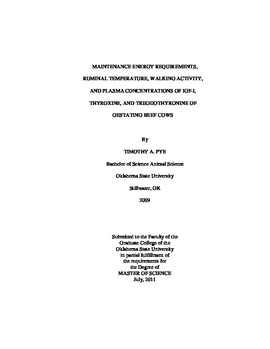| dc.description.abstract | Three experiments with spring calving, Angus cows (Exp. 1, n = 40; Exp. 2, n = 32; Exp. 3, n = 32) were conducted to determine the effects of maintenance energy requirement (MR) on plasma concentrations of insulin-like growth factor I, thyroxine (T4), and triiodothyronine (T3), walking activity, and ruminal temperature (RuT). Cows (4 - 7 yr; 5 - 7 mo gestation) with BW of 553 ± 5.9 kg, 556 ± 5.9 kg, 539 ± 8.0 kg for Exp. 1, 2, and 3, respectively, were individually fed a complete diet. Cows were initially fed a diet calculated to supply MR (Model 1, NRC 1996). Body weight was maintained for 21, 31, and 36 d for Exp. 1, 2, and 3, respectively. Blood samples were collected before and after consumption of feed on 2 d when cows consumed MR (gestation) and when cows had ad libitum prairie grass (lactation) (Exp. 1 and 2). Ruminal temperature was recorded hourly, using ruminal boluses (Smart Stock, LLC), for 4 consecutive days when cows consumed MR and when cows had ad libitum roughage (Exp. 2). Walking activity was recorded for 24 h using pedometers (Omron Healthcare, Inc.; Exp. 3). Cows were classified based on MR as low (> 0.5 SD less than mean, LMR), moderate ( 0.5 SD of the mean, MMR) or high (> 0.5 SD greater than mean, HMR). Average MR were 80.7 (SD = 4.84), 94.4 (SD = 8.00), and 95.5 (SD = 7.10) Kcal Nem?kg^-0.75?day^-1 for Exp. 1, 2, and 3, respectively. The differences between the least efficient and most efficient cow were 33, 32, and 35% for Exp. 1, 2, and 3, respectively. When cows had ad libitum prairie grass, LMR had greater concentrations of T4 compared with HMR (P = 0.05) at 1 h postprandial in Exp. 1. Ruminal temperature during maintenance and during ad libitum roughage was not influenced by MR. In Exp. 2 when cows consumed MR and were exposed to cooler temperatures (-5 °C), LMR cows had greater plasma T4 (P ≤ 0.03) compared with MMR and HMR. When exposed to warmer temperatures (15 °C), HMR cows had greater plasma T3 compared with LMR and MMR (P = 0.05). During early lactation MMR had greater concentrations of T4 compared with HMR cows (P = 0.05). When cows had ad libitum roughage during early lactation, HMR had greater (P = 0.05) plasma concentrations of IGF-I compared with LMR cows, and HMR had greater (P = 0.04) concentrations of IGF-I compared with LMR cows 1 h postprandial. Walking activity was not related to the amount of energy needed to maintain BW. Thyroxine, T3 , and IGF-I may have the potential to be biomarkers for MR. Identification of cows with lower MR could improve the profitability of beef production. | |
